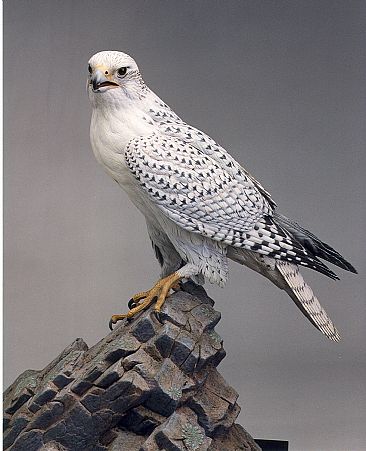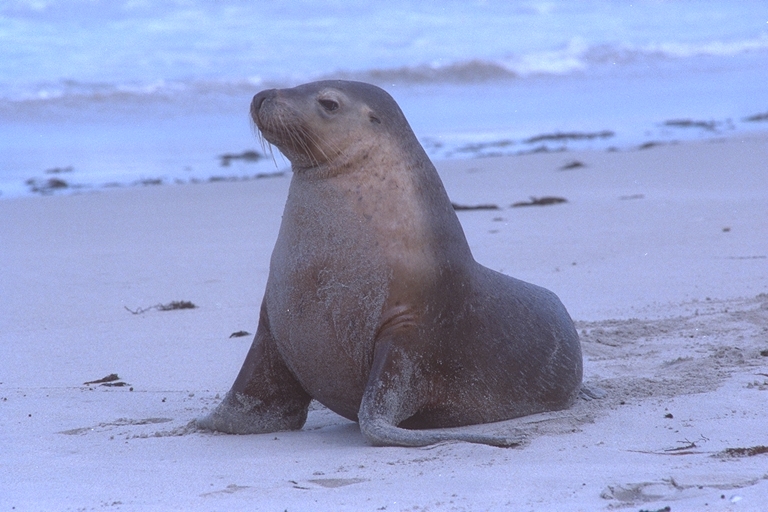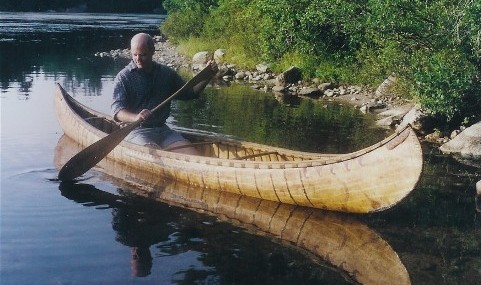
Friday, March 25, 2011
Bird #3
The male snow bunting is 6 1/4 cm almost pure white, except for his black back, central tail and primary wing feathers. In winter, his white plumage becomes rusty brown. The female has a gray-brown head and back in summer and is simply paler and duller in winter. The snow bunting spends much of its time feeding on seeds and insects on the ground, where it can run quickly and hop. The nest is made from dead grass, moss and lichen and is among stones. The female lays 4 to 6 eggs, which she incubates for 10 to 15 days. The male bird feeds his mate during the incubation period and helps to feed the young. 

Bird #2
The rock ptarmigans are 13-15 in a half inches tall they depend on camouflage for defense, and to achieve this in the changing background of their northerly range, they adopt different plumages. The summer plumage is mottled to blend with the forest, while during the winter snows ptarmigans have white plumage, only the tail feathers remaining dark. Rock ptarmigans feed on leaves, buds, fruits and seeds and on some insects in the summer. They are monogamous birds; the male defends a small territory at the breeding grounds. The female lays 6 to 9 eggs in a leaf-lined hollow on the ground and incubates them for 24 to 26 days. The cygnets must make the long migration south when only 80 to 90 days old.

Bird #1
The Gyrfalcon can be dark, white or gray. 20-25 in tall. They are Most breed north of the timberline and remain in the Arctic all year, but some populations migrate south for the winter. When hunting It can make rapid dives on prey, like the peregrine, but this is less characteristic. Birds are its main prey, although it feeds on some mammals, particularly in winter. Rock ptarmigan and willow grouse make up the bulk of the gyrfalcon's diet, and their numbers can affect its breeding rate. In years when these birds are abundant, gyrfalcons produce large clutches, but in years of scarcity they lay only a couple of eggs or do not breed at all. Gyrfalcons perform display flights when courting. When the young hatch, both parents bring food to them. 
Thursday, March 10, 2011
Mammal #3
Snowshoe Hare
The snowshoe hare has large back feet to jump through the high snow. They are usually 15-20 inch long and weigh up to 2-4 pounds. they have long ears to gather sound from predators. Their front teeth are long and sharp so that they can gnaw on tree bark and other woody plants. They have sensitive nose and long wiskers for feeding at night. They bread in early march through august, after 36 days it gives birth to about 3-4 young. Ten days after they are born they start to eat grass..The babies reach adult size in about 5 months and usually live up to 2 years.
The snowshoe hare has large back feet to jump through the high snow. They are usually 15-20 inch long and weigh up to 2-4 pounds. they have long ears to gather sound from predators. Their front teeth are long and sharp so that they can gnaw on tree bark and other woody plants. They have sensitive nose and long wiskers for feeding at night. They bread in early march through august, after 36 days it gives birth to about 3-4 young. Ten days after they are born they start to eat grass..The babies reach adult size in about 5 months and usually live up to 2 years.

Mammal #2
Sea Lion
The sea lion is a brown torpedo shaped mammal. It is shaped as a torpedo so that it can swim fast in the watter but also move on land easly.
They can stay under watter up to 40 minuts without taking a breath. They swim up to 25 mi an hour. They are near sighted animals but see better under watter. They live up to 18 years. Females come to shore with a large male of their pick to give birth. They carry the pup for about 11 months then give a live birth. Pups can wiegh up to 50lb at birth and grow up to 200lbs and 6ft long in a single year. Males weigh up to 1500 to 1 tonand 12ft long. Females weigh up to 700lbs and 9ft long. They feed on small fish.
The sea lion is a brown torpedo shaped mammal. It is shaped as a torpedo so that it can swim fast in the watter but also move on land easly.
They can stay under watter up to 40 minuts without taking a breath. They swim up to 25 mi an hour. They are near sighted animals but see better under watter. They live up to 18 years. Females come to shore with a large male of their pick to give birth. They carry the pup for about 11 months then give a live birth. Pups can wiegh up to 50lb at birth and grow up to 200lbs and 6ft long in a single year. Males weigh up to 1500 to 1 tonand 12ft long. Females weigh up to 700lbs and 9ft long. They feed on small fish.

Mammal #1
Arctic Fox
The arctic fox has white fur to blend into the snow with. It has short ears, furry soles, and a shourt muzzle so that it stays warm in the arctic temps. They live in burrows and when it snows they may make a tunnel into the snow for cover. they hunt rodents,birds, and even fish. The females give birth each spring to a litter of about 14 pups.
The arctic fox has white fur to blend into the snow with. It has short ears, furry soles, and a shourt muzzle so that it stays warm in the arctic temps. They live in burrows and when it snows they may make a tunnel into the snow for cover. they hunt rodents,birds, and even fish. The females give birth each spring to a litter of about 14 pups.

Thursday, March 3, 2011
Hudson river facts
The river is 850miles long and 650miles wide it connects to the Atlantic ocean so if I need any other way to go I can take the Atlantic ocean but that may be risky because of how big it is.
Advantages and disadvantages of my transportation
The positive things about travaling in a canoe is that its light weight easy to use and I can traval in shallow waters and it is a quiet way to get around. The disadvantage is that it is unstable and I have to paddle by myself so I may be tired very quickly.
Tuesday, March 1, 2011
Transpotation
I will be taking a canoe to my new biome. I will fallow the rivers as far as I can go and if I come to a break in the river I will have to walk the rest of the way but the rout I have chosen I will be able to use the rive most of the way.
Subscribe to:
Comments (Atom)


